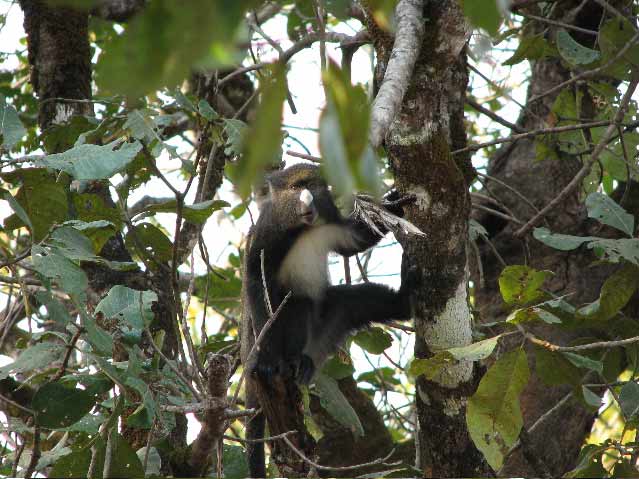Monkeys Shout Complex Thoughts

The ability to string different words together to express complex ideas was a milestone in the development of language that researchers figure occurred relatively late in human evolution.
Now for the first time, scientists reveal a primate other than humans can also express a variety of messages by combining sounds into different sequences. The finding suggests this level of language might have occurred far earlier in evolution than before thought.
Researchers focused on putty-nosed monkeys (Cercopithecus nictitans) in Nigeria. They studied alarm calls the males made.
Dangerous work
"To study alarm-calling behavior, I once dressed up as a leopard and approached a group of sooty mangabeys," recalled psychologist and primatologist Klaus Zuberbühler at the University of St. Andrews in Scotland. "The monkeys detected me, got very agitated, alarm-called at high rates, and a number of males approached in the low canopy … aggressively displaying their large canines. At this point I was glad to be able to change species (by taking off my costume) and reveal myself. They looked at me with puzzlement, and then ran away silently. It felt good to be a human!"
At other times, fieldwork was less amusing. "Kate Arnold, the lead researcher, spent Christmas and New Year in the hospital in intensive care, because she contracted heavy malaria on her way back from the field site to Scotland," Zuberbühler said. "Fieldwork in remote places in Africa is difficult for a number of reasons."
By three years of hard work trailing male putty-nosed monkeys, the researchers found the primates produced series of alarm calls that differed depending on the threat involved. For instance, a series of calls made up of "pyows" are a common response to leopards, while series of "hacks" followed by "pyows" are given to crowned eagles.
Get the world’s most fascinating discoveries delivered straight to your inbox.
By playing back recordings of calls at monkeys, Zuberbühler, Arnold and their colleagues unexpectedly found that males could arrange hacks and pyows to convey at least three different kinds of information to other monkeys — the event they witnessed, the identity of callers, and even whether they intended to travel.
Scientists had suggested that stringing different sounds together into complex ideas occurred relatively late in human evolution, speculating that such combinations only happened when doing so became easier than adding new signals to a large, unwieldy repertoire.
"Our research shows that these assumptions may not be correct," Zuberbühler said. "Putty-nosed monkeys have very small vocal repertoires, but nevertheless we observe meaningful combinatorial signaling."
Why they do it
Most primates are actually limited in the number of signals they can physically produce because of their lack of tongue control.
"The only way to escape this constraint may be to combine the few calls they have into more complex sequences," Zuberbühler said. "In other words, it may be 'harder' for non-human primates to evolve large repertoires than to evolve the ability to combine signals. Hence, the evolution of combinatorial signaling may not be driven by too many signals but rather by too few."
Since the ancestors of humanity genetically diverged from ancestors of these monkeys some 25 million years ago, these findings suggest that some of the core abilities required for human language may be much older than had been thought.
Still, "it is not clear at this point whether the communication system we describe is an isolated case — a freak of nature, so to speak — or whether it represents a more general pattern underlying primate vocal behavior," Zuberbühler said. "There are over 200 species of primates, but only a very small number of species has been studied with regards to their communication skills."
Zuberbühler and Arnold detail their findings in the March 11 issue of the journal Current Biology.
- Top 10 Missing Links
- Why Haven't All Primates Evolved into Humans?
- Top 10 Amazing Animal Abilities



